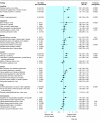Increasing response rates to postal questionnaires: systematic review
- PMID: 12016181
- PMCID: PMC111107
- DOI: 10.1136/bmj.324.7347.1183
Increasing response rates to postal questionnaires: systematic review
Abstract
Objective: To identify methods to increase response to postal questionnaires.
Design: Systematic review of randomised controlled trials of any method to influence response to postal questionnaires.
Studies reviewed: 292 randomised controlled trials including 258 315 participants INTERVENTION REVIEWED: 75 strategies for influencing response to postal questionnaires.
Main outcome measure: The proportion of completed or partially completed questionnaires returned.
Results: The odds of response were more than doubled when a monetary incentive was used (odds ratio 2.02; 95% confidence interval 1.79 to 2.27) and almost doubled when incentives were not conditional on response (1.71; 1.29 to 2.26). Response was more likely when short questionnaires were used (1.86; 1.55 to 2.24). Personalised questionnaires and letters increased response (1.16; 1.06 to 1.28), as did the use of coloured ink (1.39; 1.16 to 1.67). The odds of response were more than doubled when the questionnaires were sent by recorded delivery (2.21; 1.51 to 3.25) and increased when stamped return envelopes were used (1.26; 1.13 to 1.41) and questionnaires were sent by first class post (1.12; 1.02 to 1.23). Contacting participants before sending questionnaires increased response (1.54; 1.24 to 1.92), as did follow up contact (1.44; 1.22 to 1.70) and providing non-respondents with a second copy of the questionnaire (1.41; 1.02 to 1.94). Questionnaires designed to be of more interest to participants were more likely to be returned (2.44; 1.99 to 3.01), but questionnaires containing questions of a sensitive nature were less likely to be returned (0.92; 0.87 to 0.98). Questionnaires originating from universities were more likely to be returned than were questionnaires from other sources, such as commercial organisations (1.31; 1.11 to 1.54).
Conclusions: Health researchers using postal questionnaires can improve the quality of their research by using the strategies shown to be effective in this systematic review.
Figures
Comment in
-
Improving the response rates to questionnaires.BMJ. 2002 May 18;324(7347):1168-9. doi: 10.1136/bmj.324.7347.1168. BMJ. 2002. PMID: 12016167 Free PMC article. No abstract available.
-
Patient-reported outcome measures in arthroplasty registries Report of the Patient-Reported Outcome Measures Working Group of the International Society of Arthroplasty Registries Part II. Recommendations for selection, administration, and analysis.Acta Orthop. 2016 Jul;87 Suppl 1(Suppl 1):9-23. doi: 10.1080/17453674.2016.1181816. Epub 2016 May 26. Acta Orthop. 2016. PMID: 27228230 Free PMC article.
References
-
- Armstrong BK, White E, Saracci R. Principles of exposure measurement in epidemiology. Monographs in epidemiology and biostatistics. Vol. 21. New York: Oxford University Press; 1995. pp. 294–321.
-
- Edwards P, Clarke M, DiGuiseppi C, Pratap S, Roberts I, Wentz R. Identification of randomised controlled trials in systematic reviews: accuracy and reliability of screening records. Stat Med (in press). - PubMed
-
- Yammarino FJ, Skinner SJ, Childers TL. Understanding mail survey response behavior: a meta-analysis. Publ Opin Q. 1991;55:613–639.
Publication types
MeSH terms
LinkOut - more resources
Full Text Sources
Medical

